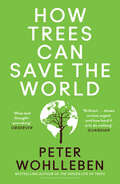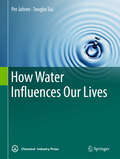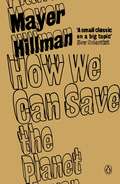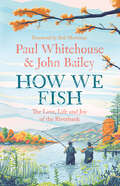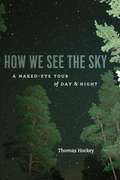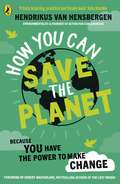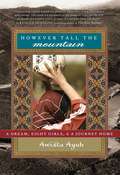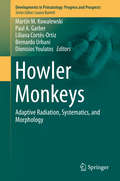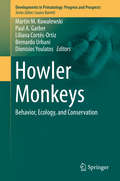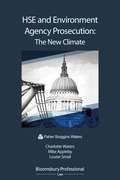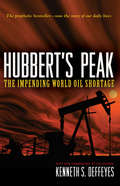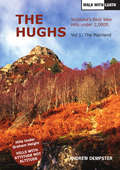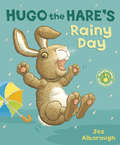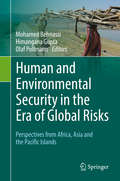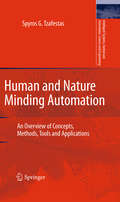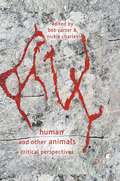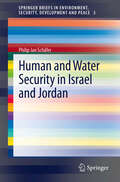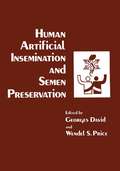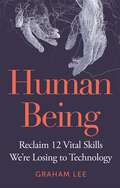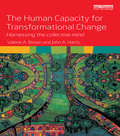- Table View
- List View
How Trees Can Save the World
by null Peter WohllebenFrom the internationally bestselling author of The Hidden Life of Trees An illuminating manifesto on ancient forests: how they adapt to climate change by passing their wisdom through generations, and why our future lies in protecting them. In his beloved book The Hidden Life of Trees, Peter Wohlleben revealed astonishing discoveries about the social networks of trees and how they communicate. Now, in The Power of Trees, he turns to their future, with a searing critique of forestry management, tree planting and the exploitation of old growth forests. As human-caused climate change devastates the planet, forests play a critical role in keeping it habitable. While politicians and business leaders would have us believe that cutting down forests can be offset by mass tree planting, Wohlleben offers a warning: many tree planting schemes lead to ecological disaster. Not only are these trees more susceptible to disease, flooding, fires and landslides, we need to understand that forests are more than simply a collection of trees. Instead, they are ecosystems that consist of thousands of species, from animals to fungi and bacteria. The way to save trees, and ourselves? Step aside and let forests – which are naturally better equipped to face environmental challenges – heal themselves. With the warmth and wonder familiar to readers from his previous books, Wohlleben also shares emerging scientific research about how forests shape climates both locally and across continents; that trees adapt to changing environmental conditions through passing knowledge down to their offspring; and how old growth may in fact have the most survival strategies for climate change. At the heart of The Power of Trees lies Wohlleben's passionate plea: that our survival is dependent on trusting ancient forests and allowing them to thrive.
How Water Influences Our Lives
by Per Jahren Tongbo SuiThis beautifully illustrated book explains how water influences our culture; the many phases of water from ice to gas, its simple but still so unpredictable nature, and water resources on Earth; how water is distributed in ice, oceans, rivers, lakes and more; how it creates transport possibilities; how it produces and absorbs energy; how it is constantly changing the surface of the Earth; how there is enough water on Earth, yet sometimes there is too much or too little; the role of water in recreation; and how water supplies us with food in a myriad of ways. Few things are like water – a subtle and thought-provoking element, so simple and yet complicated, so conspicuous yet unpredictable, so soft and peaceful yet powerful, and so universal yet unique. Water is by far the world’s largest commodity. Though it belongs to all of us, it is still not shared by all. We very seldom take time to reflect on the many ways that water affects our lives. Though it would be too ambitious to believe that it claims all the meanings and roles of water, this book, by showcasing water’s versatility and by sharing the experiences and insights gained by the two authors during their many travels across the globe, contributes to a greater awareness of the most important substance in our society – water. The book offers an insightful and intriguing read for anyone interested in science and culture related to water, from laymen to students and decision-makers.
How We Can Save the Planet: Preventing Global Climate Catastrophe
by Tina Fawcett Mayer HillmanMayer Hillman, one of Britain's most original and influential thinkers, here offers the reader both a stunning analysis of the looming environmental catastrophe and a blueprint for avoiding it. The blueprint is practical at a personal level but the challenge he throws out is to governments and business: do they have the political courage to take the necessary steps to avert the end of the world? He anticipates the counter-arguments and gives the reader the ammunition to challenge the prevailing inaction in these areas.Stimulating, challenging, frightening but also practical, this is a book that will help you make a difference.
How We Fish: The New Book From The Fishing Brains Behind The Hit Tv Series Gone Fishing, With A Foreword By Bob Mortimer
by Paul Whitehouse John BaileyPaul Whitehouse and fishing expert John Bailey celebrate the timeless joy of fishing.
How We See the Sky: A Naked-Eye Tour of Day and Night
by Thomas HockeyGazing up at the heavens from our backyards or a nearby field, most of us see an undifferentiated mess of stars—if, that is, we can see anything at all through the glow of light pollution. Today’s casual observer knows far less about the sky than did our ancestors, who depended on the sun and the moon to tell them the time and on the stars to guide them through the seas. Nowadays, we don’t need the sky, which is good, because we’ve made it far less accessible, hiding it behind the skyscrapers and the excessive artificial light of our cities. How We See the Sky gives us back our knowledge of the sky, offering a fascinating overview of what can be seen there without the aid of a telescope. Thomas Hockey begins by scanning the horizon, explaining how the visible universe rotates through this horizon as night turns to day and season to season. Subsequent chapters explore the sun’s and moon’s respective motions through the celestial globe, as well as the appearance of solstices, eclipses, and planets, and how these are accounted for in different kinds of calendars. In every chapter, Hockey introduces the common vocabulary of today’s astronomers, uses examples past and present to explain them, and provides conceptual tools to help newcomers understand the topics he discusses. Packed with illustrations and enlivened by historical anecdotes and literary references, How We See the Sky reacquaints us with the wonders to be found in our own backyards.
How We See the Sky: A Naked-Eye Tour of Day and Night
by Thomas HockeyGazing up at the heavens from our backyards or a nearby field, most of us see an undifferentiated mess of stars—if, that is, we can see anything at all through the glow of light pollution. Today’s casual observer knows far less about the sky than did our ancestors, who depended on the sun and the moon to tell them the time and on the stars to guide them through the seas. Nowadays, we don’t need the sky, which is good, because we’ve made it far less accessible, hiding it behind the skyscrapers and the excessive artificial light of our cities. How We See the Sky gives us back our knowledge of the sky, offering a fascinating overview of what can be seen there without the aid of a telescope. Thomas Hockey begins by scanning the horizon, explaining how the visible universe rotates through this horizon as night turns to day and season to season. Subsequent chapters explore the sun’s and moon’s respective motions through the celestial globe, as well as the appearance of solstices, eclipses, and planets, and how these are accounted for in different kinds of calendars. In every chapter, Hockey introduces the common vocabulary of today’s astronomers, uses examples past and present to explain them, and provides conceptual tools to help newcomers understand the topics he discusses. Packed with illustrations and enlivened by historical anecdotes and literary references, How We See the Sky reacquaints us with the wonders to be found in our own backyards.
How We See the Sky: A Naked-Eye Tour of Day and Night
by Thomas HockeyGazing up at the heavens from our backyards or a nearby field, most of us see an undifferentiated mess of stars—if, that is, we can see anything at all through the glow of light pollution. Today’s casual observer knows far less about the sky than did our ancestors, who depended on the sun and the moon to tell them the time and on the stars to guide them through the seas. Nowadays, we don’t need the sky, which is good, because we’ve made it far less accessible, hiding it behind the skyscrapers and the excessive artificial light of our cities. How We See the Sky gives us back our knowledge of the sky, offering a fascinating overview of what can be seen there without the aid of a telescope. Thomas Hockey begins by scanning the horizon, explaining how the visible universe rotates through this horizon as night turns to day and season to season. Subsequent chapters explore the sun’s and moon’s respective motions through the celestial globe, as well as the appearance of solstices, eclipses, and planets, and how these are accounted for in different kinds of calendars. In every chapter, Hockey introduces the common vocabulary of today’s astronomers, uses examples past and present to explain them, and provides conceptual tools to help newcomers understand the topics he discusses. Packed with illustrations and enlivened by historical anecdotes and literary references, How We See the Sky reacquaints us with the wonders to be found in our own backyards.
How We See the Sky: A Naked-Eye Tour of Day and Night
by Thomas HockeyGazing up at the heavens from our backyards or a nearby field, most of us see an undifferentiated mess of stars—if, that is, we can see anything at all through the glow of light pollution. Today’s casual observer knows far less about the sky than did our ancestors, who depended on the sun and the moon to tell them the time and on the stars to guide them through the seas. Nowadays, we don’t need the sky, which is good, because we’ve made it far less accessible, hiding it behind the skyscrapers and the excessive artificial light of our cities. How We See the Sky gives us back our knowledge of the sky, offering a fascinating overview of what can be seen there without the aid of a telescope. Thomas Hockey begins by scanning the horizon, explaining how the visible universe rotates through this horizon as night turns to day and season to season. Subsequent chapters explore the sun’s and moon’s respective motions through the celestial globe, as well as the appearance of solstices, eclipses, and planets, and how these are accounted for in different kinds of calendars. In every chapter, Hockey introduces the common vocabulary of today’s astronomers, uses examples past and present to explain them, and provides conceptual tools to help newcomers understand the topics he discusses. Packed with illustrations and enlivened by historical anecdotes and literary references, How We See the Sky reacquaints us with the wonders to be found in our own backyards.
How We See the Sky: A Naked-Eye Tour of Day and Night
by Thomas HockeyGazing up at the heavens from our backyards or a nearby field, most of us see an undifferentiated mess of stars—if, that is, we can see anything at all through the glow of light pollution. Today’s casual observer knows far less about the sky than did our ancestors, who depended on the sun and the moon to tell them the time and on the stars to guide them through the seas. Nowadays, we don’t need the sky, which is good, because we’ve made it far less accessible, hiding it behind the skyscrapers and the excessive artificial light of our cities. How We See the Sky gives us back our knowledge of the sky, offering a fascinating overview of what can be seen there without the aid of a telescope. Thomas Hockey begins by scanning the horizon, explaining how the visible universe rotates through this horizon as night turns to day and season to season. Subsequent chapters explore the sun’s and moon’s respective motions through the celestial globe, as well as the appearance of solstices, eclipses, and planets, and how these are accounted for in different kinds of calendars. In every chapter, Hockey introduces the common vocabulary of today’s astronomers, uses examples past and present to explain them, and provides conceptual tools to help newcomers understand the topics he discusses. Packed with illustrations and enlivened by historical anecdotes and literary references, How We See the Sky reacquaints us with the wonders to be found in our own backyards.
How We See the Sky: A Naked-Eye Tour of Day and Night
by Thomas HockeyGazing up at the heavens from our backyards or a nearby field, most of us see an undifferentiated mess of stars—if, that is, we can see anything at all through the glow of light pollution. Today’s casual observer knows far less about the sky than did our ancestors, who depended on the sun and the moon to tell them the time and on the stars to guide them through the seas. Nowadays, we don’t need the sky, which is good, because we’ve made it far less accessible, hiding it behind the skyscrapers and the excessive artificial light of our cities. How We See the Sky gives us back our knowledge of the sky, offering a fascinating overview of what can be seen there without the aid of a telescope. Thomas Hockey begins by scanning the horizon, explaining how the visible universe rotates through this horizon as night turns to day and season to season. Subsequent chapters explore the sun’s and moon’s respective motions through the celestial globe, as well as the appearance of solstices, eclipses, and planets, and how these are accounted for in different kinds of calendars. In every chapter, Hockey introduces the common vocabulary of today’s astronomers, uses examples past and present to explain them, and provides conceptual tools to help newcomers understand the topics he discusses. Packed with illustrations and enlivened by historical anecdotes and literary references, How We See the Sky reacquaints us with the wonders to be found in our own backyards.
How You Can Save the Planet
by Hendrikus van HensbergenYOU have the power to change the world!'Every young person in the country should be given this book' Sir Tim Smit, Founder of The Eden Project'A really informative book [. . .] with lots of fun ways to take practical action' Mya-Rose Craig (Birdgirl), environmental and climate activistWith a foreword by Robert Macfarlane, bestselling author of The Lost Words, this essential guide will empower and inspire young environmental activists.Combining step-by-step actions for making change and inspiring stories of children who stood up and said 'no more', this book will break down exactly what you need to do to make a difference. From building a green wall or setting up a swap shop, to using your voice as a powerful tool, you can make real change.This is the definitive guide to creating a better world wherever you live.'It's enlightening, inspiring and empowering' Kate Humble, TV presenter'Wonderfully informative, fun and practical [. . .] A great source of inspiration' The Rich Brothers, TV presenters
However Tall the Mountain: A Dream, Eight Girls, And A Journey Home
by Awista AyubA ball can start a revolution. Born in Kabul, Awista Ayub escaped with her family to Connecticut in 1981, when she was two years old, but her connection to her heritage remained strong. An athlete her whole life, she was inspired to start the Afghan Youth Sports Exchange after September 11, 2001, as a way of uniting girls of Afghanistan and giving them hope for their future. She chose soccer because little more than a ball and a field is needed to play; however, the courage it would take for girls in Afghanistan to do this would have to be tremendous--and the social change it could bring about by making a loud and clear statement for Afghan women was enough to convince Awista that it was possible, and even necessary. Under Taliban rule, girls in Afghanistan couldn't play outside of their homes, let alone participate in a sport on a team. So, Awista brought eight girls from Afghanistan to the United States for a soccer clinic, in the hope of not only teaching them the sport, but also instilling confidence and a belief in their self-worth. They returned to Afghanistan and spread their interest in playing soccer; when Awista traveled there to host another clinic, hundreds of girls turned out to participate--and the numbers of players and teams keep growing. What began with eight young women has now exploded into something of a phenomenon. Fifteen teams now compete in the Afghanistan Football Federation, with hundreds of girls participating. Against all odds and fear, these girls decided to come together and play a sport that has reintroduced the very traits that decades of war had cruelly stripped away from them--confidence and self-worth. In However Tall the Mountain, Awista tells both her own story and the deeply moving stories of the eight original girls, describing their daily lives back in Afghanistan, and how they found strength in each other, in teamwork, and in themselves--taking impossible risks to obtain freedoms we take for granted. This is a story about hope, about what home is, and in the end, about determination. As the Afghan proverb says, However tall the mountain, there's always a road.
Howler Monkeys: Adaptive Radiation, Systematics, and Morphology (Developments in Primatology: Progress and Prospects)
by Martín M. Kowalewski Paul A. Garber Liliana Cortés-Ortiz Bernardo Urbani Dionisios YoulatosHowler monkeys (genus Alouatta) comprise 12 species of leaf-eating New World monkeys that range from southern Mexico through northern Argentina. This genus is the most widespread of any New World primate and can be found to inhabit a range of forest types from undisturbed rainforest to severely anthropogenically-impacted forest fragments. Although there have been many studies on individual species of howler monkeys, this book is the first comprehensive volume that places information on howler behavior and biology within a theoretical framework of ecological and social adaptability. This is the first of two companion volumes devoted to the genus Alouatta.This volume:· Provides new and original empirical and theoretical research on howler monkeys· Presents evolutionary and adaptive explanations for the ecological success of howler monkeys· Examines howler behavior and ecology within a comparative frameworkThese goals are achieved in a collection of chapters written by a distinguished group of scientists on the evolutionary history, paleontology, taxonomy, genetics, morphology, physiology, and anatomy of howlers. The volume also contains chapters on howlers as vectors of infectious diseases, ethnoprimatology, and conservation.
Howler Monkeys: Behavior, Ecology, and Conservation (Developments in Primatology: Progress and Prospects)
by Martín M. Kowalewski Paul A. Garber Liliana Cortés-Ortiz Bernardo Urbani Dionisios YoulatosHowler monkeys (genus Alouatta) comprise twelve species of leaf-eating New World monkeys that range from southern Mexico through northern Argentina. This genus is the most widespread of any New World primate taxa, and can be found to inhabit a range of forest types from undisturbed rainforest to severely anthropogenically impacted forest fragments. Although there have been many studies on individual species of howler monkeys, this book is the first comprehensive volume to place information on howler behavior and biology within a theoretical framework of ecological and social adaptability. This is the second of two volumes devoted to the genus Alouatta.This volume:· Examines behavioral and physiological mechanisms that enable howler monkeys to exploit highly disturbed and fragmented habitats· Presents models of howler monkey diet, social organization, and mating systems that can also inform researchers studying Old World colobines, apes, and other tropical mammalsThese goals are achieved in a collection of chapters written by a distinguished group of scientists on the feeding ecology, behavior, mating strategies, and management and conservation of howlers. This book also contains chapters on the howler microbiome, the concept of behavioral variability, sexual selection, and the role of primates in forest regeneration.
HSE and Environment Agency Prosecution: The New Climate
by Charlotte Waters Mike Appleby Louise SmailSentencing guidelines impose tough penalties for health and safety and environmental offences: how can you avoid them? The introduction of the sentencing guidelines in February 2016 has seen health and safety prosecutions treble, particularly in relation to corporate manslaughter, with tougher penalties imposed and fines exceeding £20 million being handed down. With fines having a detrimental effect on both turnover and reputation, how can companies protect themselves? HSE and Environment Agency Prosecution: The New Climate is an accessible reference work that provides guidance to ensure that companies have the correct, stringent risk management and procedures in place in order to protect themselves against exposure to such fines. Through the use of worked cases studies, checklists and charts the expert advice provided is put into context, whether you are a practitioner needing to advise your client, a company director, an in-house lawyer, or a health and safety professional. Split into four sections, this new title covers:Managing Risk; The Law; Enforcement and Sentencing; Inquests and Claims.
Hubbert’s Peak: The Impending World Oil Shortage
by Kenneth S. DeffeyesIn 2001, Kenneth Deffeyes made a grim prediction: world oil production would reach a peak within the next decade--and there was nothing anyone could do to stop it. Deffeyes's claim echoed the work of geophysicist M. King Hubbert, who in 1956 predicted that U.S. oil production would reach its highest level in the early 1970s. Though roundly criticized by oil experts and economists, Hubbert's prediction came true in 1970. In this updated edition of Hubbert's Peak, Deffeyes explains the crisis that few now deny we are headed toward. Using geology and economics, he shows how everything from the rising price of groceries to the subprime mortgage crisis has been exacerbated by the shrinking supply--and growing price--of oil. Although there is no easy solution to these problems, Deffeyes argues that the first step is understanding the trouble that we are in.
The Hughs: Scotland's Best Wee Hills Under 2,000 feet (The\hughs Ser. #1)
by Andrew DempsterAndrew Dempster has 40 years’ experience of hillwalking the length and breadth of Scotland. Author of several climbing books, including the first guidebook to the Grahams, in this volume he identifies the best wee hills on the Scottish mainland.MUNRO at least 3,000ft highCORBETT 2,500–3,000ft high with a prominence of at least 500ft GRAHAM 2,000–2,499ft high with a drop of at least 150 metresHUGH (Hill Under Graham Height): under 2,000ft with exceptional characterThe Hughs all offer rewarding – and often stunning – climbs and views. Some are already popular. Many await discovery. Each one has great character. That is what the Hughs are all about.vFrom Arthur’s Seat in Edinburgh to An Grianan in the far north, from Ben Hiant in the west to Bennachie in the east, the Hughs are a phenomenally diverse range of hills, stretching to all points of the compass. Accessible to people of any age, the Hughs are not defined by the sterile logic of relative height – they are a choice of the heart.
Hugo the Hare's Rainy Day (Nat the Cat)
by Jez AlboroughHugo the Hare HATES to get wet, and when the rain comes he huddles under his umbrella. But Hugo's friends are stuck in the rain and when Hugo comes to their rescue he can't help but get all soggy!However, perhaps having a bit of a splish splash isn't quite as bad as Hugo thinks...
Human and Environmental Security in the Era of Global Risks: Perspectives From Africa, Asia And The Pacific Islands
by Mohamed Behnassi Himangana Gupta Olaf PollmannThis book discusses ways to deepen the debate on the linkages between global risks and human and environmental security. The approach put forward in this book is one of questioning the ability of existing concepts, regulatory frameworks, technologies and decision-making mechanisms to accurately deal with emerging risks to human and environmental security, and to act in the direction of effectively managing their impacts and fostering the resilience of concerned systems and resources. Empirical research findings from Africa, Asia and the Pacific Islands are provided.During the last decades the links between emerging risks and the security of humans and nature have been the object of considerable research and deliberations. However, it is only recently becoming an important focus of policy making and advocacy. In this contributed volume, it is presumed that the ability – or lack thereof – to make innovative conceptual frameworks, institutional and policy arrangements, and technological advances for managing the current emerging risks, will foster or undermine the environmental security, and consequently determine the future human security. Moreover, taking into account the links between environmental/climate security, human security and sustainability will help frame a new research agenda and potentially develop a broad range of responses to many delicate questions.
Human and Nature Minding Automation: An Overview of Concepts, Methods, Tools and Applications (Intelligent Systems, Control and Automation: Science and Engineering #41)
by Spyros G. TzafestasMan is the best thing in the World. Nature does nothing uselessly. Aristotle There is a pleasure in the pathless woods, There is rapture on the lonely shore, There is society, where none intrudes, By the deep sea, and music in its roar: I love not Man the less, but Nature more. John Burroughs The basic purpose of development is to enlarge people’s choices. The objective of development is to create an enabling environment for people to enjoy long, healthy and creative lives. Mahbub ul Hag Founder of the Human Development Report Theaimofthisbookis toprovidea compiledset ofconcepts,principles,methods and issues used for studying, designing and operating human-minding and natu- minding automation and industrial systems. The depth of presentation is suf?cient for the reader to understand the problems involved and the solution approaches, and appreciate the need of human–automation cooperative interaction, and the - portance of the efforts required for environment and ecosystem protection during any technological and development process in the society. Humans and technology are living and have to live together in a sustainable society and nature. Humans must not be viewed as components of automation and technology in the same way as machines. Automation and technology must incorporate the humans’ needs and preferences, and radiate “beauty” in all ways, namely functionally, technically and humanistically. In overall, automation and technology should create comfort and give pleasure.
Human and Other Animals: Critical Perspectives
by Bob Carter Nickie CharlesThis collection examines human-animal relations and the different ways in which they can be understood, exploring animal rights and animal welfare; whether and under what circumstances animals are regarded as social actors with agency; media representations of human-animal relations; and the relation between animals and national identity.
Human and Water Security in Israel and Jordan (SpringerBriefs in Environment, Security, Development and Peace #3)
by Philip Jan SchäferThe work aims at answering the question as to how far discourses on human security are present in Jordan and Israel, if they converge and if political solutions for the issue of water security could be derived. The analysis is based on the assumption that from human security perspective common solutions for urgent problems can be derived more easily than out of a perspective of national security. Yet it is acknowledged that according to a new security perspective different security threats are being identified by relevant actors. An empirical analysis of written statements and utterances of the respective security elites establishes the methodological tool for the identification of human security discourses in Israel and Jordan. Subsequently it is estimated how far water is presented as a matter of national security in Israel and Jordan using the theory of securitization.
Human Artificial Insemination and Semen Preservation
by Georges DavidEven though artificial insemination is a simple technique that has been practiced for over a century, it has long been carried out under poor conditions due to an inadequate understanding of repro ductive physiology and antagonistic socio-ethical attitudes. Accor dingly, until fairly recently it was a medical act with a limited scientific basis which was practised more or less clandestinely. The development of semen preservation has totally changed the conditions of artificial insemination, especially in regard to flexibility and safeguards in its application. Although the use of fresh semen continues, it is now clear that the future of arti ficial insemination is closely linked to semen preservation. During the past two decades, semen banks have been developed in many countries. This has most often been the result of the initiative of individual physicians in either the private or public sectors. In France, a national system of semen banks (CECOS) was begun in 1973. Although there has been cooperation within this system in the areas of both research and management, a need to com municate and compare experiences with those from other countries was perceived. Thus, the first International Symposium on Artifi cial Insemination and Semen Preservation was planned and held in Paris, France in April 1979. Thirty-seven countries were represented byihdividuals from many concerned disciplines.
Human Being: Reclaim 12 Vital Skills We’re Losing to Technology
by Graham LeeOur increasing reliance on digital technology has had a profound impact on our own abilities as humans. What can we do about it?In a fascinating journey through history and science, Human Being offers an insightful and provocative survey of twelve vital skills we used to call upon as a species – from navigation, conversation and memory to craft, solitude and sleep – and how we can work to reclaim them.As rapidly advancing technology embeds itself ever deeper within our lives, we rely less and less on our own capabilities. The impact on our skills and self-reliance has been immense, and, because the transition has happened so swiftly and quietly, none of us have been taught how to address the effects of our ever-increasing dependence on algorithms and artificial intelligence. Based on years of research by author Graham Lee, a digital skills educator with experience training tens of thousands of professionals, each chapter in Human Being highlights an example of when these key capabilities were at their peak, demonstrates how in a vanishingly short space of time we have embraced ways to undermine them, and provides clear, achievable guidance on how we can reverse these losses and regain our essential, human qualities.At once a celebration of human history and a timely call to action, Human Being empowers readers to build better habits around – and away from – technology, and reminds us just how extraordinary human achievement can be.
The Human Capacity for Transformational Change: Harnessing the collective mind
by Valerie A. Brown John A. HarrisPressures for transformational change have become a regular feature of most fields of human endeavour. Master-thinkers and visionaries alike have reframed existing divisions as connecting relationships, bringing together as dynamic systems the supposed opposites of parts and wholes, stability and change, individuals and society, and rational and creative thinking. This reframing of opposites as interconnected wholes has led to realisation of the power of a collective mind.This book offers ways and means of creating the synergies that are crucial in influencing a desired transformational change towards a just and sustainable future. It describes how and why our current decision-making on any complex issue is marked by clashes between the different interests involved. More optimistically, the book pursues a mode of thinking that brings together government, specialised and community interests at the local, regional and personal scales in a collective transformation process. Practical examples signal the emergence of a new knowledge tradition that promises to be as powerful as the scientific enlightenment. Written in accessible language, this book will be insightful reading for anyone struggling with transformational change, especially researchers, students and professionals in the fields of administration, governance, environmental management, international development, politics, public health, public law, sociology, and community development
